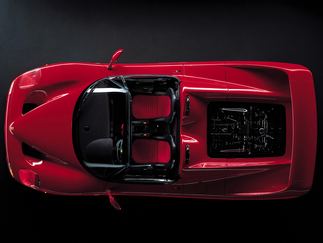1995 Ferrari F50 by Pininfarina
- Story Cars

- Nov 5, 2021
- 3 min read
This Pininfarina styling mock-up of the Ferrari F50 was manufactured in Maranello in a limited number. Its objective was to synthesize the best racing characteristics of an F1 single-seater with those of a road car: high technology, excellent aerodynamic efficiency, extreme performances combined with absolute reliability and safety.
“Our market research says Ferrari customers believe F1 is the pinnacle of all automotive technology, the highest peak of their motoring aspirations,” former Ferrari sales and marketing director Dr. Michele Scannavini said in the mid 1990s. “By offering them a chance to buy an F1 car dressed as a road car, we’re going as close as we can to meeting those aspirations.”
An “F1 car dressed as a road car” sums up the Ferrari F50.
The idea for this F40 successor came from Piero Ferrari, then the company’s vice chairman. He drove an F40 to the office daily, and with Ferrari concentrating its racing focus on Formula 1, that made F1 a perfect starting point for Maranello’s highest performing new road car.
In 1990, when work on the Ferrari F50 began, Ferrari’s F1 cars used a carbon-fiber chassis, a naturally aspirated V-12 engine, pushrod suspension, and paddle-shift transmission. All would make it to the Ferrari F50, save the shift paddles because of durability concerns.
The tub followed Formula 1 engineering principles. It was the central part of the car’s structure and was made entirely of lightweight carbon composites and adhesive materials. Acting as a support for the rear suspension and for the carbon-fiber bodywork was the centrally mounted engine.
And what an engine it was. The 4700cc V-12 used the 1990 F1 car’s block. It employed a similar design for the heads and crankshaft; this made the latter items easier to manufacture. Everything else was new so the engine could meet emissions laws and be drivable on the street. At 513 horsepower, the Ferrari F50 was Ferrari’s most-powerful road car ever.
The gearbox was a conventional six-speed manual mounted longitudinally. The suspension featured upper and lower wishbones, pushrods, and electronically controlled shocks managed by an ECU that took into account steering angles and lateral and longitudinal forces. This not only minimized body roll but made the ride more comfortable. The brakes were large ventilated Brembo discs and were not power assisted.
Originally, Ferrari wanted Pininfarina to make two different bodies for the car -- a slinky aerodynamic coupe and a barchetta. Pininfarina’s head of design was Lorenzo Ramaciotti, and the earliest Ferrari F50 proposals drew from his stunning Ferrari Mythos show car of 1989. To pass U.S. crash tests, the body of the road car had to be lengthened, and once the general shape was decided, it underwent extensive aerodynamic testing.
“Our priority was to find a good balance between airflow on and inside the car by utilizing underbody aerodynamics,” Ramaciotti said. Spoilers were added as necessary, and lessons learned developing the Ferrari F50’s flat underbody were tapped for the smaller F355.
A full-scale styling model was presented to Ferrari in 1991. At that point, Ferrari management told Pininfarina to merge the coupe and barchetta into a single car. The design of the resulting open two-seater with a lift-off roof panel was barely touched until shortly before the car’s introduction at the 1994 Geneva Motor Show, when roll bars were added for additional occupant protection.
Ferrari capped Ferrari F50 production at just 349 units, one fewer than it figured it would be able to sell. Most of the earliest cars went to America, delivered before emissions regulations tightened in 1997. Ferrari had no trouble selling out the production run, even at a factory sticker of nearly $520,000.
That was roughly half the asking price of the other preeminent supercar of the day, the McLaren F1. That the Ferrari F50 couldn’t quite match the McLaren’s performance numbers was of no importance to Ferrari. Its goal was to construct the world’s most involving drive, and that’s exactly what Ferrari F50 owners got.
Not that 0-100 mph in 8 seconds and the quarter-mile in 12.1 was slow. It was about the experience. As Road & Track summed up in the test that recorded those figures, “More than anything the [Ferrari F50] feels like a racing car.”
Ferrari had hit its target, and the car was so special inside the company that it had its own production line. When the last Ferrari F50 rolled out in 1997, few were sadder to see it go than Ferrari test driver Dario Benuzzi. “Developing the car has been a wonderful adventure,” he told Autocar. “I do not want it to end.”
Sources: pininfarina spa.; auto.howstuffworks.com
Images: pininfarina spa.


























































Comments